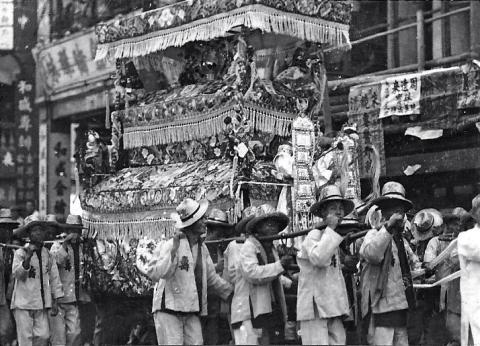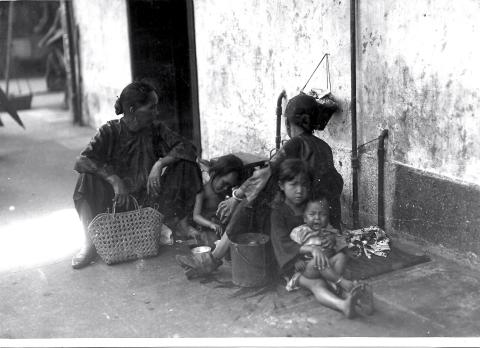At our Convent: Ma Mere,the Reverend Mother,was French; and the Head Mistress of the school, Ma Soeur Beatrice, was English. Sister Beatrice was severe, and we were rather afraid of her. Most of the nuns were French, with a few Chinese and Portuguese.
My favourite nun was Ma Soeur Alix. She came out from France in 1922, aged about 26, and was teacher of the top class. She was kind and sympathetic, and never lost her temper. If she left the classroom and we took advantage of her absence and began talking, she would come in again smiling, with her hands over her ears, exclaiming in her very French accent "What a cacophony"! In her class, the naughty girls always sat in front and the good girls at the back! I do not know how we learned English from so French a nun, but when I passed my matriculation at the University, I won a Distinction in English.
Sister Alix taught the 4th (top) Class, Sister St. Louis (and later Sister Elizabeth) taught the 3rd Class, Sister St. Leon the 2nd Class, Sister John the 1st Class, and Sister Blandine (and later Sister Lawrence) the Babies' Class. Sister Cecile was the sewing teacher. I cannot remember ever learning anything except cross stitch in red cotton from her! Sister Vincent was the music teacher and there was always the sound of the piano. She used to shout angrily at us from the window of the music room, when our loud voices in the playground disturbed a piano lesson.
The nuns liked to organise entertainments. I can remember "Queen of the Roses", with Audrey and some of the other younger girls as Rose Fairies. On another occasion, I was "Britannia", wearing a helmet. And once there was a grand fancy dress party, when we were all photographed on the school steps, Rosie Xavier and I both dressed as Watteau shepherdesses.
We Church of England girls used sometimes to join the Catholics in the school chapel, with its ornate statues, and the altar decorated with lilies, and the strange aroma of incense. We sang the Lourdes "Ave Maria" and "Heart of Jesus", and were given Jesus pictures by the nuns. On the wall of our class room hung a large picture of St. Therese of Lisieux, the Little Flower, our nuns' favourite saint. Occasionally Catholic priests would visit the classrooms. They were French or Italian with huge black beards. The nuns would flutter around them, and we girls would feel nervous.
The playground of the Convent and the stone steps leading up to the school were crowded with pots of flowering plants, marguerites covered with white blooms, and sweet smelling heliotrope, and many others. The Chinese excelled in pot gardening.
From the playground we could see into the cellars. There were cases and cases of wine. The nuns would come into class after tiffin gently breathing whiffs of wine over us.
In the dining room sometimes we had the school tiffin, but usually we brought sandwiches, envying the Chinese girls whose amahs appeared from home with grand hot meals in enamel containers fitted one on top of another. After tiffin we often went out and bought nuts or fruit from the Chinese stalls.
The Convent girls were of many nationalities - English, French, Chinese, Portuguese, Scottish, Siamese, Parsee, Spanish, German, American and Eurasian.
Our best friends among the Chinese were Jean, May and Alma 0 Hoy (they were from Australia), Agnes Pau., Ruby Chue, Frances and Sylvia Heyshing, and Julia Lam. I used to wish that I could draw and paint as well as Julia did. But all the Chinese girls seemed to find it quite easy to produce exquisite flower paintings, whenever the nuns demanded them of us. Agnes Pau was clever and rather serious. She became one of Hong Kong's teachers, and headmistress of a big school. Parrin Ruttonjee, a Parsee of India, loved to read the magazine "Titbits", and used to pass them on to me to enjoy the jokes. She was one of our-cleverest girls, and became a distinguished Hong Kong doctor.
Emily Landolt was partly Swiss and partly Japanese. I liked her for her easygoing, laughing nature. Lily Shearer was partly English and partly Japanese - she was a boarder at the Convent, very gentle and sweet and rather holy - the girls used to say she would become a nun. Yvonne and Cecilia Phalavasu were Siamese; Mary Soriano was Spanish; Mercedes Muller was German; Simone and Marcelle Gain, and their little identical twin sisters, Marie—Louise and Marie-Therese, were French. Rosie Xavier, Ernina Remedios, Leonora Collaco, Marie Nolasco and Lina Silva-Netto were Portuguese, Kathlynne Naylor and Dorothy and Katie Kirschberg were American, and came as boarders from the Philippines. Kathlynne was sophisticated, and I admired her and became her friend, but she hated the Convent and soon left Hong Kong. She used to write to me from California and send me pressed Mariposa lilies and other Californian flowers. Gladys Addison and her sister, half English and half French, came from the romantic Seychelle Islands.
There was a large group of Scottish girls, daughters of employees of the Taikoo Dockyard - among them were, Betty Laing, Jenny Whyte, Jean Foulds, Mamie Wallace and Cathie Ferguson. We called them "The Taikoo Girls". Some of the English girls were Vera Stanley, Joyce and Iris Thornhill, Beatrice Hardwick, Lily and Katie Grimes, Daphne and Patsy Nicol, Irene Deacon, Zena Bersey, Marjorie Hansen (who was partly Danish) and Nancy and Kathleen McEwen (partly Scottish). Marjorie and Nancy were my two best English friends - they joined the Girl Guides with me. Zena was a lively little girl from Cornwall, very pretty with black curly hair, whose father had a fine voice and sang at concerts. Zena herself loved to sing "My beautiful my beautiful" (the Arab's farewell to his steed). Among our other school friends were Gertie and Kathleen Simmons, and Ruby, Rosebud and Vivienne Young, all of whom were exceptionally pretty; and Tootsie and Connie Smith.
Fat cheerful Daphne Nicol got appendicitis and died. We all went to her funeral, and hysterically threw earth on to her coffin. Poor Mrs. Nicol had masses of photographs of Daphne copied and distributed among her school friends.
Diary pages from this date
The funeral processions were very dramatic. A band came first,
playing weird sad music, then the coffin, carried on poles on
men's shoulders, and following it the mourners, all dressed in white
and sack cloth, their heads covered in large white hoods. They cried
and wailed at the tops of their voices, and had to be supported by
servants, in case they should collapse. These people were often
professional mourners who had been hired by the family, and the
more noise they made, the more honour to the dead person.
Then came a large framed photograph of the deceased, carried
on high for all to see. And finally all sorts ofmarvellous things
made of white paper, carried on poles, animals, birds and flowers,
to be burnt at the funeral.
Chinese graves were very elaborate and beautiful. They were dotted
about on the slopes of hills in the New Territories, and were made
of carved stone, looking almost like wide chairs leaning against the
hillside with arms enclosing a stone floor. In the centre of the
gravestone was a door, behind which was the coffin, and on the
stone floor in front stood little vases with joss sticks in them.
In our early days in Hong Kong we often saw women with bound
feet, wearing tiny embroidered shoes. They moved slowly, leaning
on the arms of servant girls, one on each side, because they could
not walk alone.
In those days Chinese ladies wore high necked jackets and long
skirts, beautifully coloured and embroidered. On their heads they
wore wide bands of embroidered silk, in front only, so as not to
disturbtheir buns and hairpins at the back. They wore earrings and bracelets, of jade and gold. The gentlemen wore jackets and long
gowns, and black skullcaps with a red pompom on top. Both sexes I
think wore soft shoes.
By the time I left Hong Kong, the women were wearing cheong sam,
tight fitting dresses with skirts split up the sides, so attractive on
slim Chinese figures. The men by then were dressed in foreign
suits.
In 1922 the Prince of Wales visited Hong Kong on his Far Eastern
tour. Never was there such excitement, or tremendous preparations.
There were receptions and parades for him, and firecrackers; and
wonderful decorations, especially at night when all the Royal Naval Fleet in the Harbour were outlined in lights and buildings were
ornamented with large crowns made of electric lights.
The Girl Guides paraded for the Prince on Murray Parade Ground,
a proud occasion for usI And on another day we went with our
school to be inspected by the Prince, and the Governor, Sir
Reginald Stubbs.
Murray Parade ground was a great place for parades. Empire Day,
May 24th, was always celebrated with great ceremonial, also the
King's Birthday in June, when the Governor inspected the Troops,
the Navy, Marines and Police. He used to look splendid in his white
uniform and plumed helmet.
We grew up in an atmosphere of military bands playing stirring
music and soldiers drilling and marching. This was part of a British Colony, and we were immensely proud of being a small portion of
the great British Empire. England was always called "Home" with
a capital "H", and people would talk of "going Home on leave".
Mamma would tell us nostalgically of the beautiful English countryside
with its wild flowers.
But to Audrey and me, England was just a name. Hong Kong was
our home. Living among the Chinese as we did, we felt an affinity
with them, and admired their commonsense, patience, courtesy
and humour. We seemed to laugh at the same things. Our Amah
was the soul of kindness and loyalty, and could never do enough for our mother and us.
We grew up beside the Chinese noise and exuberance, their shouting,
chanting, firecrackers, music, the hawkers calling out their wares; the
beggars calling "Cumshawl", the rickshaw coolies - "Shaw?", and
the chair coolies - "chair?".
Perhaps Mamma never quite got used to all this. She was always
afraid that we might catch some dreadful disease; and it was
ages before she would allow us to go to the Chinese New Year Fair,
and then only when we had promised to be careful and not let
anyone bump into us! We all had to be vaccinated against smallpox
regularly every few years, and if there was an epidemic of it we got an extra vaccination. Or if a cholera or typhoid or some
such epidemic, we were inoculated against them.
Police men were much in evidence, most of them Chinese, or
large Sikhs with turbans and black beards; the Superintendents
and Inspectors being British. There had to be a good Police force in
such a place as Hong Kong, where bad characters could come and
go quite easily over the Border. Still, there were many robberies,
and we were careful to hold our handbags tightly.
Part of the fascination of Hong Kong lay in the mixture of many
races of people, ours and the Chinese, and the Portuguese, the
Eurasians and all the others.

